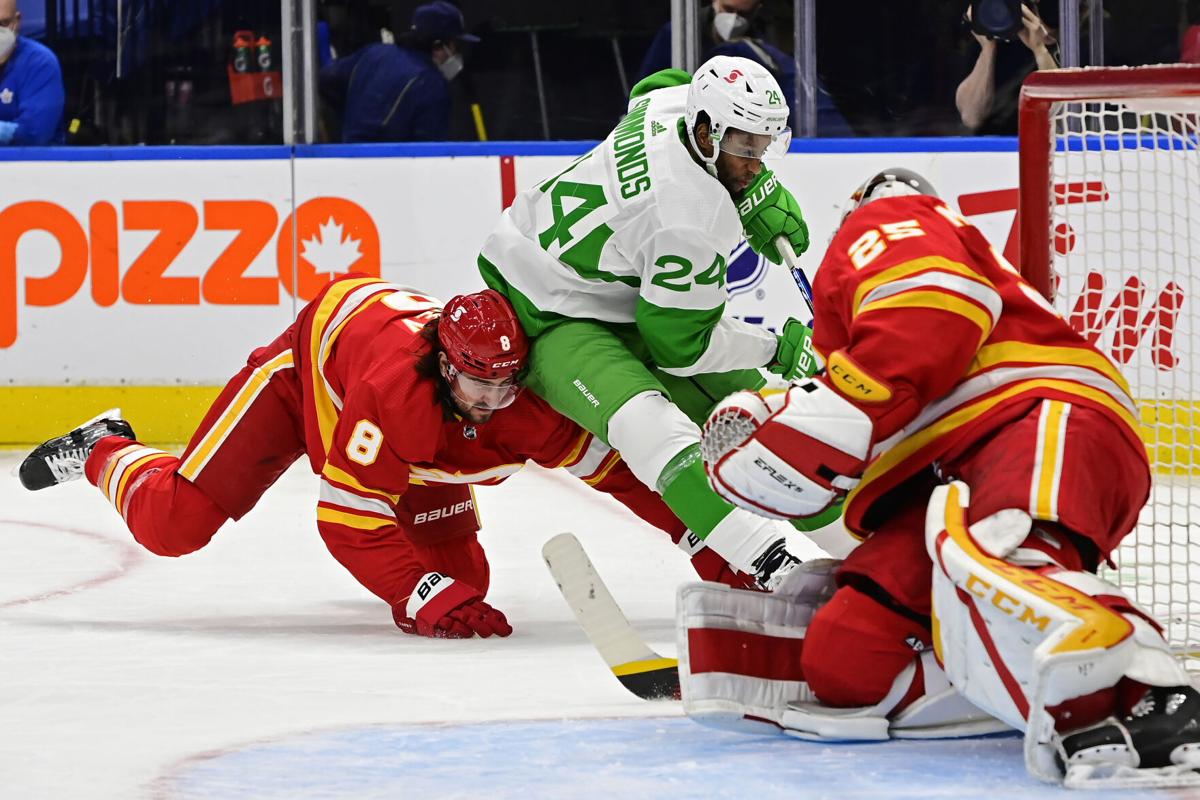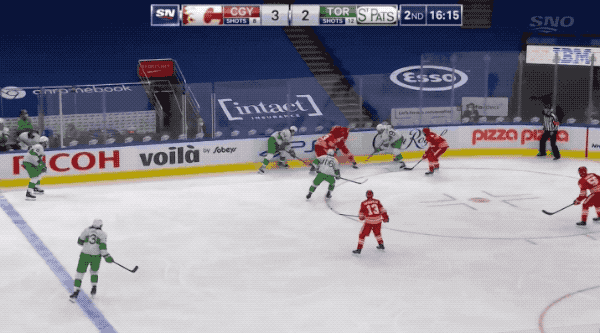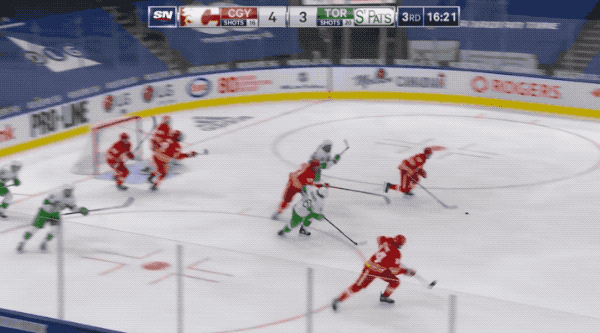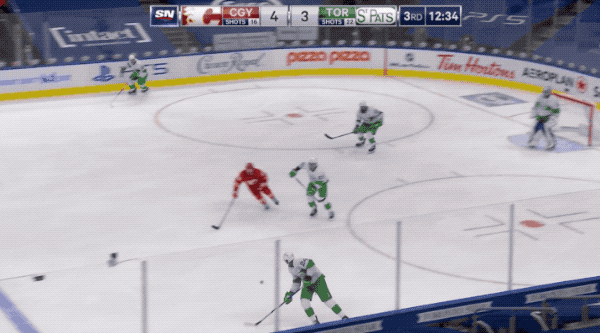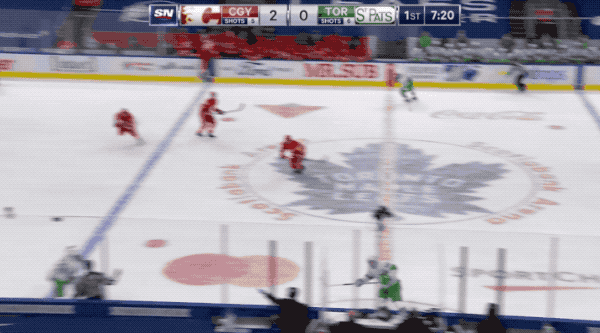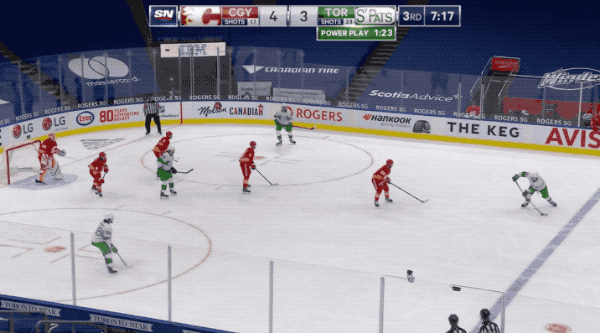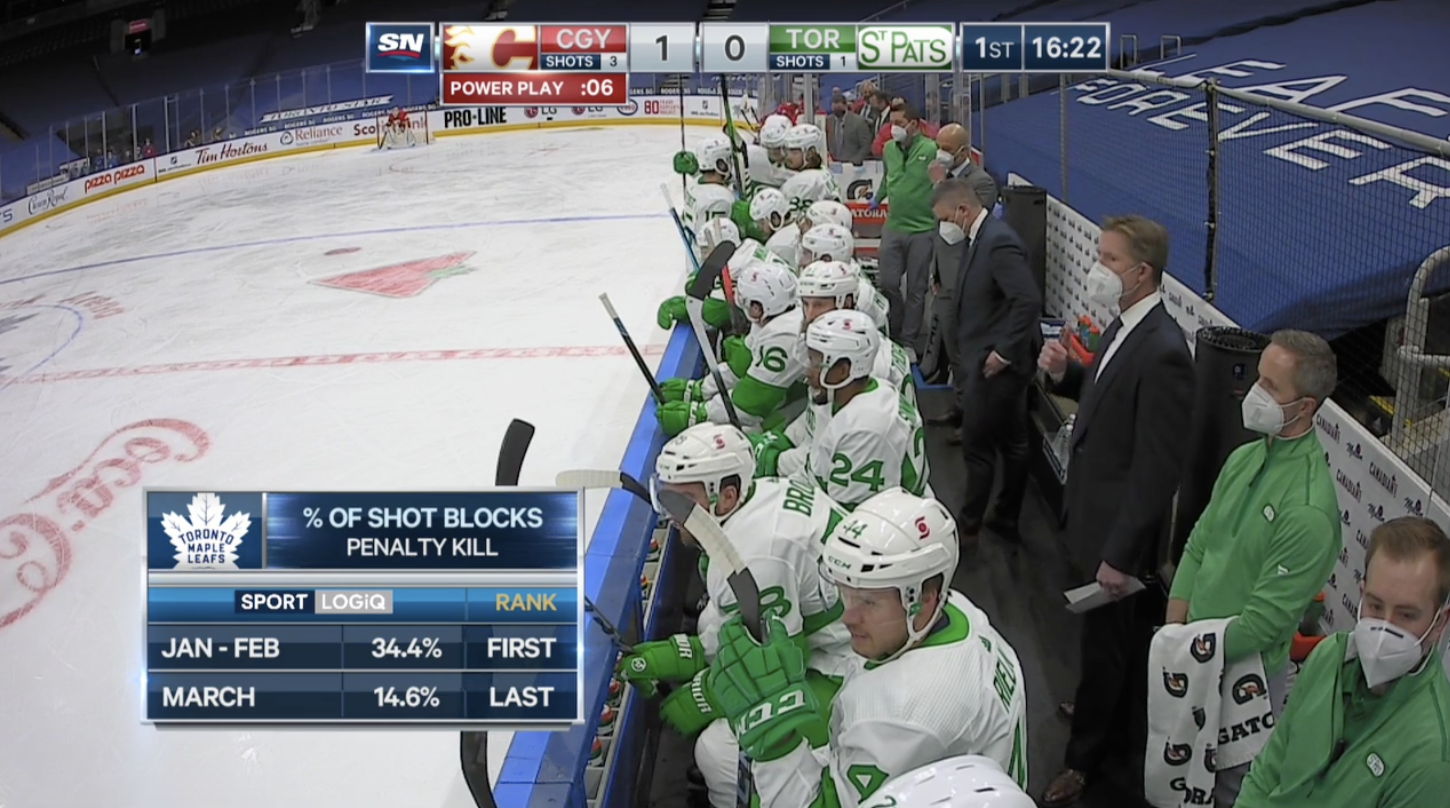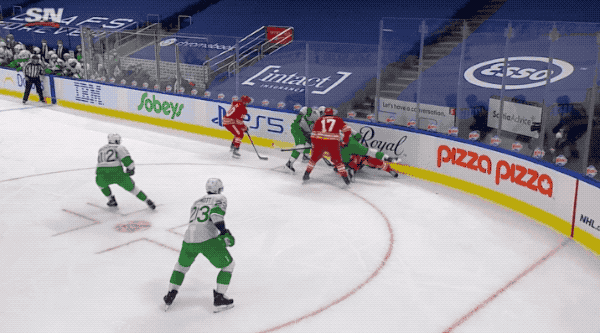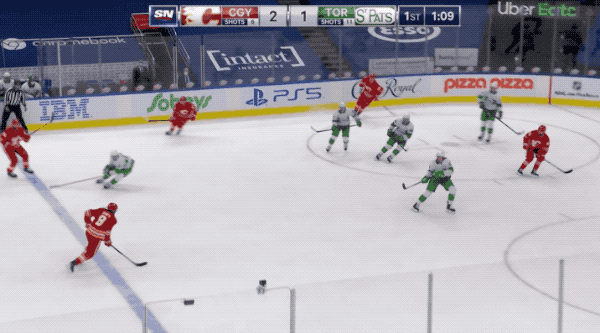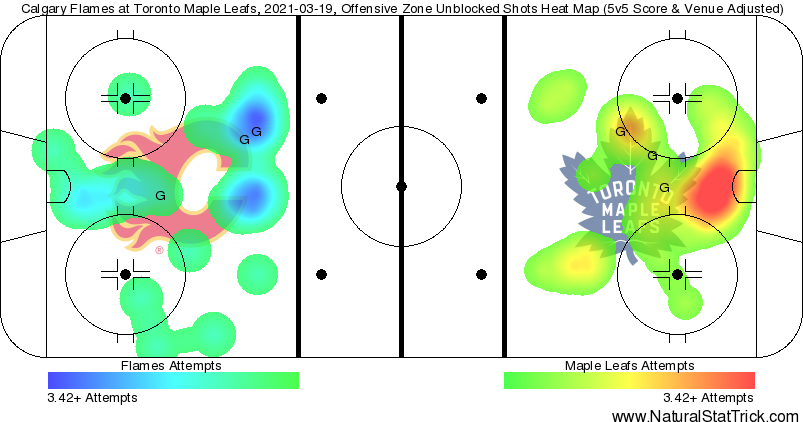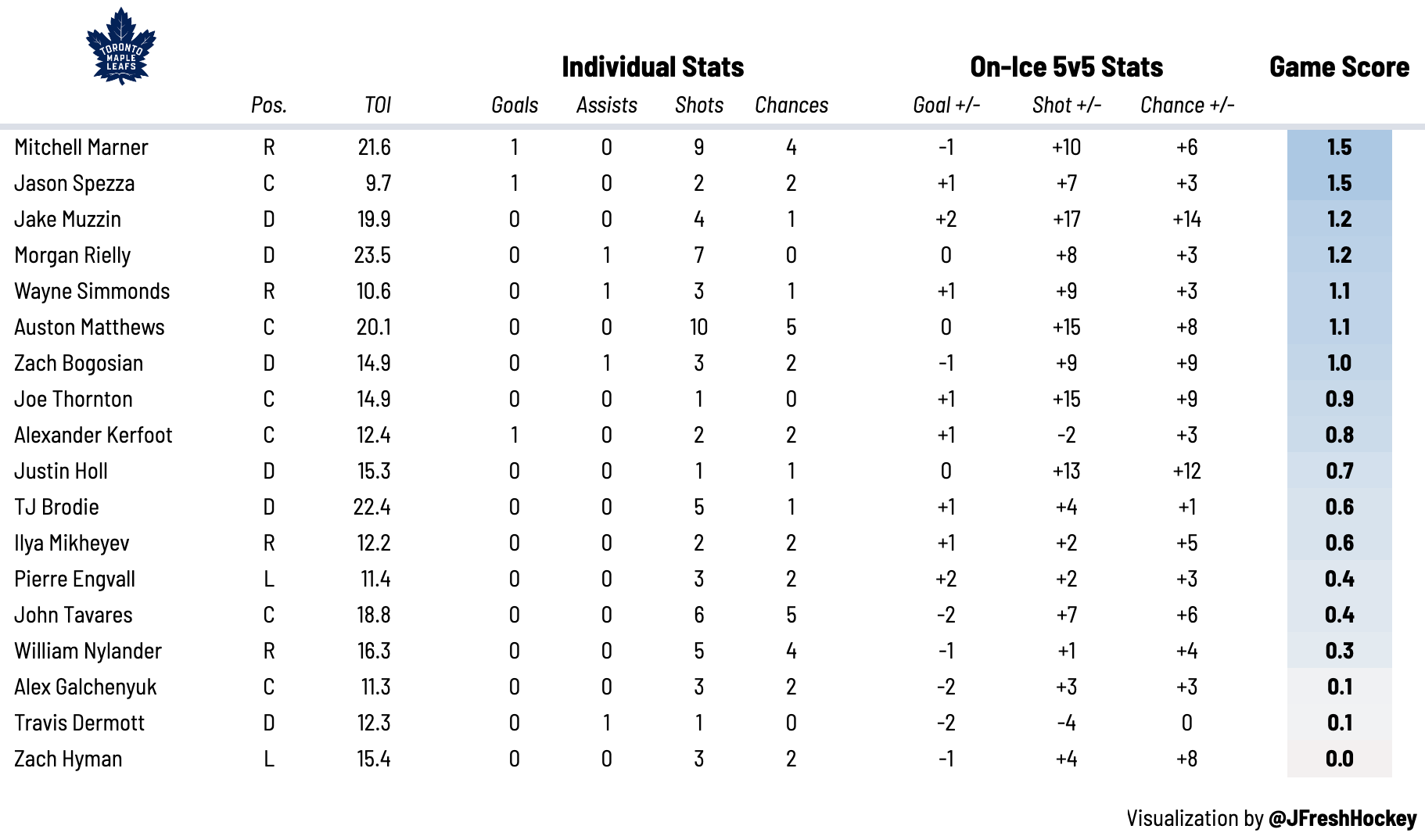Sometimes you just need a ****ing save.
Since hiring Daryl Sutter, the Calgary Flames have been a dominant team at 5v5. The Toronto Maple Leafs significantly outplayed them at even strength tonight — and lost 4-3.
After riding some sky-high shooting percentage and save percentage luck to start the season, the PDO reckoning appears to be in full swing. Frederik Andersen struggled again between the pipes, which we’ll break down in more detail towards the end.
Just keep in mind this Leafs team has actually been playing good hockey lately despite some shoddy goaltending.
*Angry mob begins to light their pitchforks*
I better get out of here before I get hurt. Let’s dive into some player grades!
5 Stars
Game Puck: Mitch Marner (RW, #16) — His wrist shot looks much more dangerous this season. I’m not sure if it’s because he’s getting more power on it or if there’s a deceptive aspect to the release that he’s been working on, but one thing is for sure: Marner has been beating NHL goaltenders with it consistently this season.
That’s his 12th goal of the year, which would put him on pace for 32 goals across an 82-game season.
Marner was also making some great passes as per usual, finding Auston Matthews in tight for a chance that rang off the goal post later in the third period.
What impresses me most about Marner is that he’s able to generate all that offense while being defensively responsible. The Leafs encourage their defensemen to roam around in the offensive zone, which means you need your third forward to dart back as fast as they can to prevent odd-man rushes.
Marner has arguably been the best in the team in that regard this season.
This is just one example, but it’s a good one. Even Johnny Gaudreau can’t pull away from Marner when he reaches top speed.
4 Stars
Alex Galchenyuk (LW, #12) — How many of us expected Alex Galchenyuk to be a puck-hound in his first game as a Leaf? Right from his first shift, you could tell he was giving a high-level effort on every forecheck.
It’s a big part of the reason his line was able to force pucks loose below the goal line. I’d expect we’ll see some more flashes of skill from Galchenyuk moving forward, considering he’s averaged 47 points per 82 games throughout his NHL career.
Commitment to play without the puck has always been the concern with him, so it’s a great sign that he excelled in that department tonight.
Wayne Simmonds (LW, #24) — Another first! This was Wayne Simmonds’ first game since February 6th and he didn’t look out of place. He was finishing his checks, driving hard to the net, and surprisingly, making some great plays in transition.
My biggest concern with Simmonds at 5v5 is that plays tend to die on his stick in the neutral zone. The opposite was true in this game. He actually helped create Jason Spezza’s goal with a quick little pass to gain the zone.
Jason Spezza (LW, #19) — Since we’re already talking about that goal, here’s what it looked like.
That’s a nice little play by Simmonds to start the passing sequence. Spezza follows it up with an east-west pass, a lucky bounce if we’re being honest, and then a big shot that beats Markstrom.
The fourth line looked good tonight, thanks in large part to Spezza and Simmonds’ strong play.
TJ Brodie (RD, #78) — If you want to beat a Darryl Sutter-coached team, it starts on the breakout. Calgary’s forecheck has been relentless since the coaching change, but Brodie was able to “solve” it on multiple occasions by threading a little slip pass through the middle of the ice in the defensive zone.
Sometimes it’s the simple plays that make a big difference.
The Muzzin-Holl Pair — Anytime you outshoot and out-chance the opposition by double digits at 5v5, you know you’re doing something right. The Leafs generated 14 more chances than Calgary when Jake Muzzin was on the ice, thanks in large part to smart pinches in the offensive zone and closeouts in the neutral zone.
Justin Holl had himself a game. Two fights, a few big hits, strong transition defense, and a Grade-A scoring chance. I’m still not sure what Matthew Tkachuk was doing when he circled around center ice after challenging Holl to a fight, but honestly, I think we’d all sleep a lot better if we stopped worrying so much about his antics.
3 Stars
Auston Matthews (C, #34) — It’s been weird evaluating this version of Auston Matthews from night to night. He doesn’t look like himself in that his wrist injury is preventing him from getting the power on his shot that we’re used to seeing, but he’s still been able to get himself into some really good shooting positions.
He finished the game with 10 shot attempts, five of which came from the slot. If not for an incredible save from Jacob Markstrom, this would have been the game-tying goal.
Some nights the Hockey Gods just aren’t with you.
Joe Thornton (LW, #97) — I was really wondering if he’d finish the game with zero shot attempts in classic Jumbo Joe fashion, but he did fire one puck towards the net in the third period.
Despite providing almost no value as a shot threat, Thornton was able to complete a few cross-ice passes in the offensive zone. He was looking for Matthews on most of those, as he should be.
William Nylander (LW, #88) — This was a weird one for me because I genuinely thought Nylander looked dynamic off the rush. He almost snuck a shot under Markstrom’s skate on one of his rush chances.
On the cycle, though, I’d like to see more from Nylander. Maybe it’s a bit of acclimatizing to his new linemate, but the “spacing” in the offensive zone for the Tavares-Nylander line seemed a little bit off to me.
Ilya Mikheyev (LW, #65) — Another night, another Ilya Mikheyev PK rush that leads to a 1% chance of beating an NHL goaltender. It’s legitimately impressive how consistently he’s been able to strip pucks and create offense the other way while shorthanded, but he needs to find a better finishing move when he attacks the net.
At 5v5, he was disruptive in his puck pursuit (as usual), although he wasn’t able to create much offensively (as usual).
Zach Bogosian (RD, #22) — There were a few times Bogosian, smartly, decided to gap up in the neutral zone and kill the play early. It’s not always easy for defensemen like Bogosian to make aggressive plays like that given his footspeed, but he made some calculated risks in transition that benefited his team greatly.
2 Stars
Morgan Rielly (LD, #44) — Sometimes the iron is your best friend. Rielly’s most memorable play of the game was a tape-to-tape turnover in the middle of the defensive zone, leading to a backdoor pass that beat Andersen but not the post.
Rielly did a good job of holding the line in the offensive zone and starting the breakout in the defensive zone, and a blocked shot of his led to a primary assist on the Jason Spezza goal. Unfortunately, he whiffed on his best scoring chance of the evening. Even more unfortunately, it was a last-minute one-timer with the goalie pulled.
Alex Kerfoot (C, #15) — Yes, he scored a goal, but it was a lucky wobbler on a 1v3 rush. Kerfoot provided value on the penalty kill with some good stickwork, although his 5v5 impact still leaves a lot to be desired. Frankly, I’d be surprised if he’s still on the team a month from now.
Zach Hyman (RW, #11) — He was doing his usual work along the boards, getting body position on the opposing defender so he could win loose pucks back for his team. When he was forced to make a play in open ice, though, Hyman struggled tonight.
He’s done a much better job transporting the puck this season, especially in that third-line role where he’s forced to “drive” the line. We didn’t see as much of that in this game.
Pierre Engvall (C, #47) — There are times he’ll make a play that looks like it shouldn’t be possible. Sometimes it’s getting his stick on a puck that should be out of his reach. Sometimes it’s creating a transition opportunity when things looked pretty clogged up.
My theory is it’s his unusual combination of speed and length that catches opponents off guard. Aside from those few moments, this was a pretty quiet night for Engvall.
Coaching Staff — It’s not Sheldon Keefe or Dave Hakstol’s fault that shots are beating Andersen from the blueline. However, it is the coaching staff’s job to make life easier on his goaltender.
Small sample size warning obviously, but this strikes me as something structural that can be fixed. If your penalty killers aren’t getting in the shooting lanes, it’s going to increase the chance of those long-distance floaters finding their way through traffic.
John Tavares (C, #91) — We won’t be adding this one to Tavares’ highlight reel.
At least he picked up the secondary assist, right?
Tavares was able to help make up for this blunder, generating five chances from the slot, not to mention a no-look pass to Matthews for a one-timer that Markstrom absolutely robbed.
If we’re going to evaluate him as a captain, though, we need to acknowledge the 200-foot penalty he took with 17 seconds left in the 2nd period. There’s a time and place for everything. That wasn’t it.
1 Star
Travis Dermott (LD, #23) — Some of it was bad luck, but when you’re the one standing in the slot and the puck zips by you for a goal against, it’s hard to not knock the defender for it. This happened twice to Dermott, who had a puck bounce off his glove on the first goal. He jumped out of the way on the second one, which was an interesting strategy, to say the least.
Frederik Andersen (G, #31) — Oh boy.
In the first period, Andersen allowed three goals despite Calgary only generating 0.26 expected goals (that’s really low). A bad bounce and a backdoor pass can do that to you sometimes, but I’d love to hear a good explanation for this one finding the back of the net.
You need a save there.
The fourth goal against deflected off of Muzzin’s butt, so it’s hard to blame Andersen too much on that one. The bigger problem is that the Leafs have had the second-best goaltender in their last few Andersen starts. Even tonight, Markstrom wasn’t spectacular, but he was better.
Jack Campbell is going to get the start on the second half of the back-to-back. Anything short of an abject disaster and I’d say he keeps the net moving forward.
Heat Map
Here’s a quick look at where each team’s shots were coming from at even strength, courtesy of Natural Stat Trick.
As you might’ve guessed, the Leafs controlled the run of play at 5v5 tonight. They generated 60 percent of the shots and 73 percent of the scoring chances.
Game Score
Game score is a metric developed by The Athletic’s Dom Luszczyszyn to measure single-game performance. You can read more about it here.
Tweets of the Night
Goaltending clinic tonight. Love to see it.
— Bryan Hayes (@HayesTSN) March 19, 2021
After the first period, I’d argue both goalies played better than most of us remembered. Then again, both Markstrom and Andersen gave up floaters.
when you’re definitely not watching the leafs game https://t.co/ivFh83GrC8
— dom at the athletic (@domluszczyszyn) March 20, 2021
On nights like these, I really wish I could do Raptors Report Cards instead.
https://t.co/MjXn8O1vvq pic.twitter.com/dj8glh6wWk
— artur akhtyamov believer (@briancrd) March 20, 2021
Have analytics gone too far?
I'm just spit-balling some ideas here, but a number of years back Matt Cane found that SV% tends to rise as goalies face more shots. Frederik Andersen has started facing considerably fewer high shot count games over the past couple years. https://t.co/xNXoyCCwYS pic.twitter.com/ng7ImFXmdb
— draglikepull (@draglikepull) March 17, 2021
This is an interesting theory. When Andersen faced a high volume of shots, his save percentage was great. Now that he’s facing a lower volume of shots, his save percentage is poor. Coincidence?
The Leafs have a 63% share of scoring chances in those seven games, second in the NHL.
Their save percentage is .858, which is 29th.
— James Mirtle (@mirtle) March 20, 2021
The Leafs have actually been dominating play at 5v5 lately. They just need a save.























